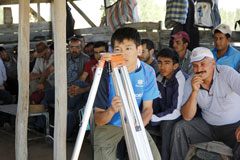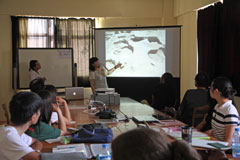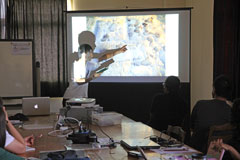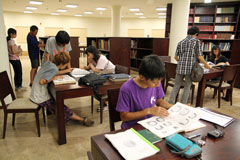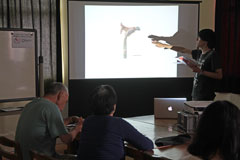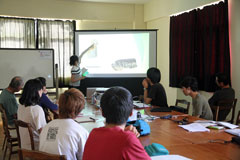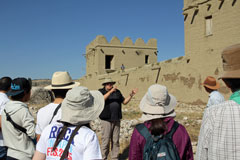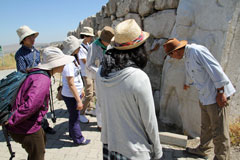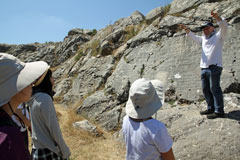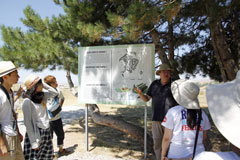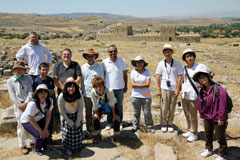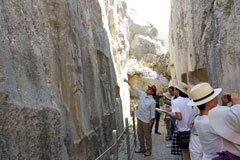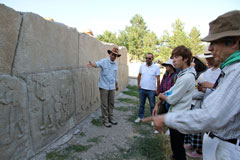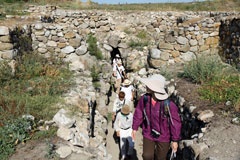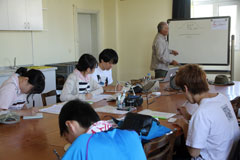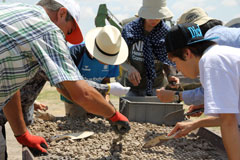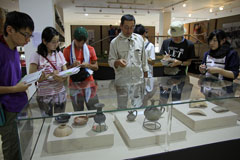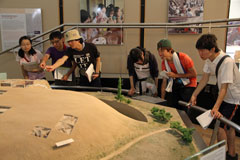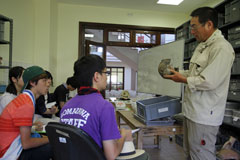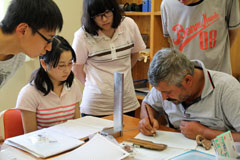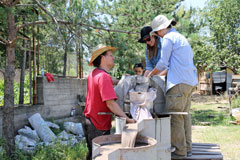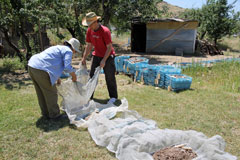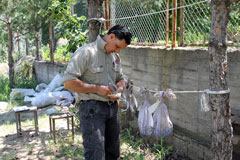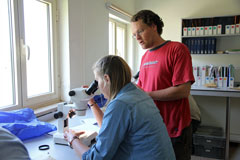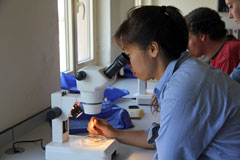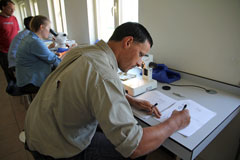フィールドコース
フィールドコースは、考古学及び関連分野に興味を持つ学生、若手研究者を対象に、カマン・カレホユック発掘調査を基盤に、出土した遺物等を使って、研究の基礎知識、方法を指導する入門コース、さらにより研究を深めるためのアドバンスコース等、時々に応じて専門家によってアレンジされます。今までに、保存修復、植物考古学、動物考古学、形質人類学、古環境学、考古学等の分野で行なわれてきました。
■考古学フィールドコース(2015年)終了(3)
考古学フィールドコース(2015年)が、15日(土)の午後の授業をもって終了しました。今回のフィールドコースは、今までにない程の暑さに見舞われたことで、連日参加者の学生の中で日射病などで体調を崩す者も出る始末。ただ、最終日の15日には全員回復、遺物研究の発表も無事済ませ、16日の午前中にアナトリア考古学研究所を後にしました。来シーズンも考古学フィールドコースを開催する予定ですが、詳細は近日中にアナトリア考古学研究所のホームページに掲載致します。(2015年8月24日)
■考古学フィールドコース(2015年)遺跡見学(2)
考古学フィールドコースに参加している日本の学生を中心として、8月9日、世界遺産にも登録されているボアズキョイ(古代名ハットゥシャ)の見学会が行なわれました。日本の学生の他にもトルコの学生が参加し、なかなか賑やかなフィールドトリップとなりました、6時半に研究所を出発、9時半にはボアズキョイの村に到着。その後、帝国時代の大神殿、獅子門、突撃門、王門、宮殿址、ボアズキョイ考古学博物館、帝国時代の葬祭殿のヤズルカヤ、そして最後に帝国時代の主要都市アラジャホユック(古代名アリンナ)を見学しましたが、その中でもボアズキョイの発掘現場をA.シャフナー隊長の案内で見学が出来たのが何よりでした。(2015年8月12日)
■考古学フィールドコース(2015年)開始(1)
アナトリア考古学研究所が主催する考古学フィールドコースは、8月2日から始まりました。日本から札幌学院大学、中央大学、駒沢大学、明治大学から6名の学生が参加、3日は「アナトリ考古学概論」の授業を受けたあと、早速カマン・カレホユック遺跡の発掘調査に入りました。発掘現場では、遺跡の層序、発掘の仕方、遺物の取り上げなどの授業に続いて、6名の学生は北区と南区に分かれて実際に作業に取り掛かりました。ここ数日の気温は異常に高く、45度を超す中での慣れない発掘に果敢に挑戦していました。各発掘区にはウスタ(親方)がおり、彼らを中心に調査は進められています。ウスタとのコミュニケーションはトルコ語ですので、ここ数日は発掘を行なうと同時にトルコ語を夢中になって勉強しています。毎日行なわれる夕方6時のミーテッイングでは、その日の発掘がどのように行なわれたかを英語で説明する必要もあり、昼食が終わる3時以降はその準備に没頭しているようです。フィールドコースは15日の土曜日まで続き、16日に研究所を離れる予定です。(2015年8月8日)
■2015 Archaeobotany Field School at the JIAA
The 2015 Archaeobotany Field Course at the JIAA was taught by Dr Rohan Fenwick (The University of Queensland, Australia), and was attended by a keen group of budding archaeobotanists from The University of Queensland and Macquarie University. Using excavated materials from Kaman-Kalehöyük, as well as modern plant specimens from our reference collection, we discussed a range of topics including introductory botany, identification of plants and plant anatomical structures (seeds, fruits, and wood charcoal), plant and human ecology, and the ways in which plants may be preserved in – and recovered from – archaeological sites. We also examined actual preserved plant remains from Kaman-Kalehöyük, and discussed the ways in which such remains can shed light on past human cultures and subsistence.
During the field course we placed special emphasis on learning practical field methods, and the students were especially enthusiastic about learning the principles and methods of the ongoing JIAA archaeobotanical flotation programme (even if they got a little dirty at the flotation machine!). Students were also very interested in learning about recent advances in our understanding of cereal domestication, as well as about the ground-breaking archaeobotanical research being done at Kaman-Kalehöyük. Field excursions to the Kaman-Kalehöyük Museum, and also to the modern agricultural fields around the JIAA compound, helped to show how the research on plant remains can be placed into a much wider context. The students enjoyed themselves very much, and I hope that the field course has helped to inspire a new generation of archaeobotanical researchers! (2015年7月20日)(Dr Rohan Fenwick)
